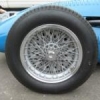First up, my main focus is the crew of the medical car, as I have repeatedly stated.
Second, do you want me to list out the occasions when inadequately equipped marshals have stood by and let a driver burn to death? This is a situation you believe is appropriate, and want to perpetuate?
Yes, a driver's helmet is probably not the appropriate headgear for the average marshal, but it doesn't take a lot of imagination to scheme out a more suitable but still effective arrangement. My three layer suit cost me under well $1k, I have had it it a number of years (I concede it may have lost some effectiveness over that time).
As marshalling generally is not the focus of my interest here, I'll leave it to you to figure out how you are going to be ready to assist the driver of a burning car get out.
(As a driver, I respect and appreciate the volunteer marshals who give their time to enable me to enjoy my sport - more power to you and your colleagues 
 )
)
Interesting glimpse into the mid-set of a race driver.
Willing to wear the same set of overalls for several years but clamouring for better equipment for marshals (though then claiming that are only really focusing on the medical car crew).
In the Grosjean crash, it was only the fact that it occured during the first lap of the race, and at an early part of the lap, that the medical car crew were able to be present within a short time period.
For the other 98+% of the race they would not have been out on track and the driver would be reliant on actions of the track-side marshals, so maybe you should concentrate you attentions more on that area.
There are of course a couple of easily identified improvements that come to mind.
Maybe the drivers should take greater care to try avoid having accidents and, if they find it really necessary to have an accident, then try and ensure that they have it in a section of the circuit that is easily accessed by an adequate no of marshals.
Is it really necessary for the MC crew to be wearing 3 layer overalls etc? apart from maybe giving the race drivers a little bit more confidence.
In an earlier post you pointed out that the race driver has to endure the overalls for a whole race (max 2 hrs), conveniently forgetting that they can have a nice clean set for the next session and have the opportunity take a shower in the interim.
I somehow doubt that the MC crew has that opportunity, as they are effectivly on duty for the whole time the track is live, including for the support race sessions, and probably just about get time for a quick comfort break in the gaps between the sessions.
![]()
























